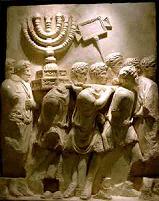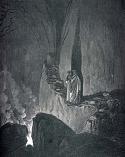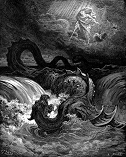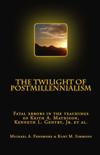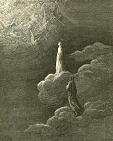What is the "Gathering" of Matt. 24:29-31
Matt. 24:29-31 describes the coming of
Christ in the events culminating in the destruction of
New Testament Imagery and Sources
The term "gather" is used in several
parables to describe agricultural activity associated with
harvest. John the
Baptist thus opened his ministry saying that the Messiah would
"gather" the wheat into his garner, but the chaff he would burn
up with unquenchable fire (Matt. 3:12).
The imagery of gathering and sorting the wicked from the
just is tied to the end of the world/age, and the second coming
of Christ. We see
this, for example, in the parable of the net and fishes:
"Again the kingdom of heaven is like unto a net, that was cast
into the sea, and gathered of every kind: Which, when it was
full, they drew to shore, and sat down, and gathered the good
into vessels, but cast the bad away. So shall it be at the end
of the world: the angels shall come forth, and sever the wicked
from among the just, and shall cast them into the furnace of
fire: there shall be wailing and gnashing of teeth" (Matt.
The word "gather" in these passages is from
the same Greek word in Matt. 24:31 (Grk. episunacousiv).
Another passage setting forth this same lesson is the
parable of the wheat and tares (Matt.
That the gathering of the saints involves
their martyrdom is reasonably clear from the context of II
Thess. 2:1-9. There
the church in Thessalonica was frightened and unsettled,
supposing the end time was upon them. Paul told them the time
was not yet at hand, and would arrive only after the "man of
sin" and "son of perdition" was revealed. Most Preterists
recognize that the revealing of the man of sin describes the
persecution under Nero. Notice, however, that Paul describes the
crisis that would overtake the saints as a "gathering":
"Now
we beseech you, brethren by the coming of our Lord Jesus Christ,
and by our gathering together unto him, that ye be not soon
shaken in mind…for that day shall not come except…that man of
sin be revealed, the son of perdition" etc.
(II Thess. 2:1-3).
Thus, the gathering unto Christ is clearly
connected with the revealing of the man of sin.
The argument may be stated thus: The saints would be
gathered at the revelation of the man of sin (Nero).
The revelation of the man of sin was the persecution
under Nero. Therefore, the saints would be gathered in the
persecution under Nero.
This is confirmed by Rev. 14:9-16.
Rev. 14 describes the persecution under the
beast, and warns believers against yielding to the pressure to
obey the civil authority by denying Christ:
"And
the third angel followed them, saying, with a loud voice, If any
man worship the beast and his image, and receive his mark in his
forehead, or in his hand, the same shall drink of the wine of
the wrath of God, which is poured out without mixture into the
cup of his indignation; and he shall be tormented with fire and
brimstone in the presence of the holy angels, and in the
presence of the Lamb" (vv. 9-10).
The passage then promises the saints rest
if they abide faithful, dying for their Lord:
"Here
is the patience of the saints: here are they that keep the
commandments of God, and the faith of Jesus. And I heard a voice
from heaven saying unto me, Write, Blessed are the dead which
die in the Lord from henceforth: Yea, saith the Spirit, that
they may rest from their labours; and their works do follow
them" (vv. 12,13).
We believe the "rest" promised here is
depicted by the martyrs reigning with Christ a thousand years in
Hades Paradise in Rev. 20:4-6. But in any event, immediately
following the assurance of reward if they abide faithful unto
death, Jesus is portrayed seated upon a cloud, harvesting the
wheat of the earth. The implication is that the harvest is
accomplished by martyrdom under the beast:
"And
I looked, and behold, a white cloud, and upon the cloud one sat
like unto the Son of man, having on his head a golden crown, and
in his hand a sharp sickle. And another angel came out of the
temple, crying with a loud voice to him that sat on the cloud,
Thrust in thy sickle, and reap: for the time is come for thee to
reap; for the harvest of the earth is ripe. And he that sat on
the cloud thrust in his sickle on the earth: and the earth was
reaped" (vv. 14-16).
Here then is the eschatological harvest of
the saints: The parables in the gospel foretold the harvest, but
did not explain how it would be accomplished. Here, however the
answer is provided.
The closing verses of the chapter portray the harvest of the
grapes of wrath (Jews) tread "without the city" (vv. 17-20).
It is interesting that wheat harvest occurs about June,
but the vintage is not ripe until fall. Thus, chapter fourteen
follows established agricultural facts.
The symbolism also follows the history of the persecution
and the Jews war with
Old Testament Sources - Jubilee Trumpet
Matt. 24:29-31 and Isa. 27:13 are very
similar, and many commentators believe that both speak to the
same event. However, this is wrong.
Here is the text of Isa. 27:13:
"And
it shall come to pass in that day, that the great trumpet shall
be blown, and they shall come which were ready to perish in the
land of Assyria, and the outcasts in the land of Egypt, and
shall worship the Lord n the holy mount at Jerusalem."
The passage in Matthew also mentions a
trumpet, and on this basis the it is supposed the same events in
view. We agree that
Jesus appropriates the language of Isaiah, but this is because
the theme is the same, not the subject matter. Isaiah is talking
about the return of the captivity out of
"In
the day of atonement shall ye make the trumpet sound throughout
all your land. And ye shall hallow the fiftieth year, and
proclaim liberty throughout all the land unto all the
inhabitants thereof: it shall be a jubilee unto you: and ye
shall return every man unto his possession, and ye shall return
every man unto his family" (Lev. 25:9, 10).
This is clearly the source of Isaiah's
imagery, when the Jewish captives in
After the Tribulation of those Days
Here is the whole text of Matt. 24:29-31;
notice when the gathering would occur:
"Immediately after the tribulation of those days shall the sun
be darkened, and the moon shall not giver her light, and the
stars shall fall from heaven, and the powers of the heavens
shall be shaken: And then shall appear the sign of the Son of
man in heaven: and then shall all the tribes of the earth mourn,
and they shall see the Son of man coming in clouds of heaven
with power and great glory. And he shall send his angels with a
grout sound of a trumpet, and they shall gather together his
elect from the four winds, from one end of heaven to the other."
The tribulation here is not talking about
the tribulation that would overtake the Christians in the
persecution under Nero or the Jews in the war with
"And
ye shall hear of wars and rumours of wars: see that ye be not
troubled: for all these things must come to pass, but the end is
not yet. For nation shall rise against nation, and kingdom
against kingdom: and there shall be famines, and pestilences,
and earthquakes, in divers places, all these are the beginning
of sorrows" (Matt. 24:6-8).
When Jesus says "immediately after the
tribulation of those days" it is to these events, preceding his
return and the fall of
Conclusion
The gathering of Matt. 24:29-31 refers to
the end-time harvest of the saints, when they were gathered home
to Christ in death under the Nero and the Jews.
To receive Kurt Simmons’ e-mail newsletter, The Sword & The Plow, click the Subscribe link:
All rights reserved.
